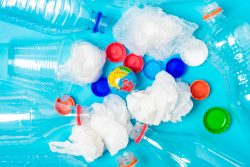 BPA has been a staple in the manufacturing of plastics and consumer goods since the 1950s. However, it wasn’t until 1993 that scientists discovered its alarming effects, including leaking from polycarbonate flasks and acting similarly to the female sex hormone estrogen. Even more disconcerting, BPA has demonstrated its ability to accelerate the growth of breast cancer cells. Additional research has uncovered the harmful impacts of BPA on various bodily systems including the neurological, cardiovascular, reproductive, immune and endocrine systems.
BPA has been a staple in the manufacturing of plastics and consumer goods since the 1950s. However, it wasn’t until 1993 that scientists discovered its alarming effects, including leaking from polycarbonate flasks and acting similarly to the female sex hormone estrogen. Even more disconcerting, BPA has demonstrated its ability to accelerate the growth of breast cancer cells. Additional research has uncovered the harmful impacts of BPA on various bodily systems including the neurological, cardiovascular, reproductive, immune and endocrine systems.
A recent study discovered that BPA was present in almost 93% of the 2,517 individuals who were tested. Notably, higher levels of BPA were found in younger participants. Furthermore, a 2020 European study conducted across 11 countries and involving 2,756 adults revealed that 92% of them exceeded the recently updated “tolerable daily intake” for BPA and its substitutes.
New findings indicate that even though products are labeled as BPA-free, the alternatives used, specifically bisphenol-B (BPB) and bisphenol-S (BPS) may have harmful effects similar to BPA. Research suggests that BPS can disrupt the normal functioning of hormones and lead to abnormalities in chromosomes.
Environmental and consumer advocates have successfully advocated for stricter regulations on the widespread presence of BPA. While restrictions differ across countries and jurisdictions, some have imposed limitations on its usage in products that come into contact with food and beverages. However, due to its prevalence in the manufactured environment, it may be difficult to completely eliminate. BPA is omnipresent in various aspects of daily life, including building materials, plastic food and drink containers, pipes, electronics, flooring, clothing and even receipts. Furthermore, it has been discovered in rivers, drinking water, soil, and the air.
To safeguard against harmful BPA exposure, experts recommend the following:
Limit canned foods and switch to glass containers.
Avoid using plastic in microwaves and dishwashers.
Wash hands after handling receipts.
Beware of hand sanitizers and skin care products that may contain compounds enhancing BPA absorption through the skin.
Coenzyme Q10 (CoQ10) has shown promising results in reducing BPA-linked DNA damage and embryonic defects, thus supporting female fertility.
Consider sweating through saunas or exercise as a potential way to eliminate BPA, as studies have found higher BPA concentration in sweat than in blood or urine.
Adequate folate intake guards against autism linked to BPA exposure. Additionally, genistein, a flavonoid present in soybeans, fava beans, miso, alfalfa, and broccoli, along with methyl donor nutrients like folic acid, can effectively reverse the harmful effects caused by BPA. To ensure sufficient folate intake, consumption of dark green, leafy vegetables, fruits, beans, liver, eggs, whole grains, and fortified foods is highly recommended.
It is crucial to minimize exposure whenever feasible, but it is also important to recognize that we possess effective tools to combat the adverse consequences.
To view the original scientific study click below:
Bisphenol-A and phthalate metabolism in children with neurodevelopmental disorders





